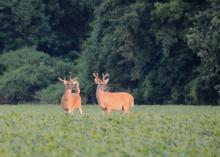Information Possibly Outdated
The information presented on this page was originally released on May 22, 2015. It may not be outdated, but please search our site for more current information. If you plan to quote or reference this information in a publication, please check with the Extension specialist or author before proceeding.
Plant warm-season food plots for deer
STARKVILLE, Miss. -- Summer is a critical season for white-tailed deer, especially in the Deep South.
Adult does are lactating, fawns are growing, and bucks are producing new antlers. The nutritional needs of each developing animal are high. If landowners and managers are going to plant warm-season food plots of quality legumes, they should plant between mid-April and early June. These forages can be an excellent way to supplement the natural food sources provided by Mother Nature in a well-maintained habitat.
Warm-season food plots provide additional protein for deer in the area. This nutritional boost comes in handy during the stressful times commonly occurring in summer months.
The majority of a deer’s diet during the warm growing season comes from leaves and stems of native broadleaf plants. In spring and early summer, the new growth of native vegetation is high in protein and complex carbohydrates. By mid- to late summer, protein production slows down as plants enter their later growth stages.
In addition, plant stems and leaves of natural vegetation become tough, making them more difficult for deer to digest and extract nutrients. As a result, deer must eat more food and expend greater amounts of energy looking for food. All too often, deer are still unable to obtain the necessary levels of protein to rebuild their bodies and to grow fawns and antlers.
What are the protein values that deer need to reach their growth potential? Minimal protein levels in forage required for antler development differ with a buck’s age, but 16 to 18 percent is typically what is needed to maximize antler size.
Adult does require at least 11 to 15 percent protein during late pregnancy, but after fawning, they need somewhere between 14 and 22 percent protein for best milk production. Younger animals that are actively growing require much higher levels of protein than adults.
There are several recommended legume species for warm-season plantings, including cowpeas, bush-type soybeans, wildlife soybeans, Lab Lab, Alyce clover and deer joint vetch. Of these, cowpeas will usually give you the biggest bang for your buck. Soybeans are likely the most palatable food-plot forage, but they can be difficult to establish unless the plot is very large, at least 30 acres.
There are several varieties of cowpea, but iron and clay cowpeas are probably the most tried and true. While deer don’t like cowpeas as much as they do soybeans and some of the other warm-season legumes, cowpeas are still a high-quality forage. Cowpeas have a good growth rate, and with proper planting and timely rains, they are able do well on a wide range of soil types. In addition, they can provide more than 22 percent protein and stand up well to heavy grazing. On average, cowpeas cost less than a dollar per pound, and seed is usually easy to find at the local seed store.
Cowpeas do just fine as a stand-alone crop but also can be planted with a companion crop of corn or grain sorghum. While these can be very productive food plots, corn and grain sorghum both are grasses, which presents a problem for using selective herbicides to manage grass weeds. From the standpoint of using selective herbicides to control grasses, a better option is to plant sunflowers as a companion crop.
The purpose of planting warm-season food plots is to improve diet quality for the deer herd on your land or leased hunting property during a nutritionally stressful period. Many hunters plant cool-season food plots to help deer through the winter stress period, but they often neglect warm-season plots. Food plots that provide deer with protein-rich forages during the summer are the most practical and economical way to achieve this goal, especially on lands where there is little to no active management of native vegetation.
For more information about seed varieties, planting rates, planting methods and soil pH ranges, please refer to Extension Publication 2111, “Supplemental Wildlife Food Planting Manual for the Southeast.”
Also, visit http://www.msudeerlab.com to download the free white-tailed deer food plot app for your iPhone.

Editor’s Note: Extension Outdoors is a column authored by several different experts in the Mississippi State University Extension Service.







